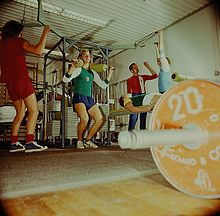Weight training
Weight training is a term that designates a type of sport or a type of sport. The weight sports require a particularly high level of strength and therefore correspondingly developed muscles . Typical strength sports are weightlifting , powerlifting, and arm wrestling . Since weight classes apply in many strength sports, the development of high, specific strength is the primary goal and the most important influencing variable that limits success.
The history of weight training goes back to ancient Greece and developed early in Central Europe.
In strength sports, in addition to movement technique, the quantitative and qualitative development of the muscles and thus the increase in muscle strength are in the foreground. This is usually done through regular training with dumbbells and other weights made of metal or hard plastic in various load intensities and with appropriate repetitions as well as an optimized diet . Depending on the intensity of the exercise, the muscle develops a larger cross-section and / or greater muscle tension. There is also an improved coordination (intramuscular coordination). In addition, there is the training of coordination between the muscles (intermuscular coordination) by the brain and thus the musculoskeletal system as a whole (which is automatically performed when the training exercise is performed). In strength athletes, you will find both “high-speed strength”, i.e. type IIx fibers and “strength endurance” or type IIa fibers in a specially trained form.
The bodybuilding is strictly a weight training because the objective only the greatest possible muscle growth is here and the strength gains rather is a side effect. However, since the training here is very similar to that of typical strength sports ( strength training ), it can definitely be included in this group. In bodybuilders' muscles one finds predominantly trained "strength endurance fibers" (type IIa).
Apart from some disciplines of athletics that live from speed strength , dynamic maximum strength is at the fore , at least in the weight training variants of heavy athletics that are exercised in the hall. This dynamic maximum force is the greater the more weight can be moved arbitrarily and specifically, so z. B. the weight that a strength athlete can bench press from the chest to the highest position. The goal of strength training is to increase this dynamic maximum strength. The dynamic maximum force depends on various influencing factors, at least not all of which can be influenced by the athlete himself. If one disregards the equipment conditions of the training area (the machine, the type of dumbbell or the training device) and the biomechanical or anatomical requirements of the athlete, one comes to the following influencing variables:
- Enlargement of the muscle fiber cross-section ( muscle hypertrophy )
- The structure of the muscle
- Intramuscular coordination
- The muscle stretching
- The athlete's motivation
- Nutritional status
In various other sports in which the goal is of a technical nature, the athletes also sometimes need and develop great strength and correspondingly developed muscles, especially in the throwing disciplines of athletics (e.g. shot put ), track cycling (sprint) and alpine ski racing . However, the focus is more on speed strength or strength endurance.
literature
The "Schäfer" collection of the Lower Saxony Institute for Sports History in Hanover is the most extensive collection on the history of catch wrestling and strength sports in Europe and is open to users.
